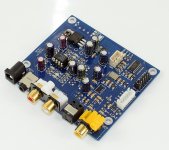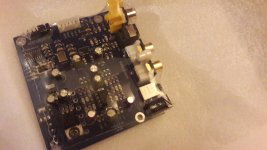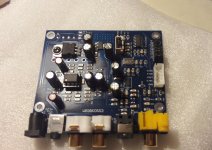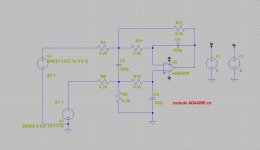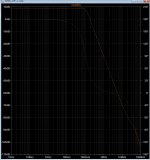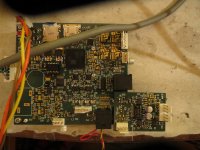so my 50 cent to it:
today the ES9038Q2M from taobao/ebay/Kguss arrived, i call it the "blue" one:
for me it sounds absolutely "platy", sounds like plate/sheet..changed immidiately to Muses02; not far better..
i guess it really needs the 15V; have here now 12V (plug)..
something really important is missing; don´t know if its a "crappy"-made pcb or something..
absolute no comparison to my old ES9018K2M and ES9028Q2M-chinese-boards; they sound far more hifi, are superior..
with my Skysong-USB-bridge its almost unbearable and on a Pi (via I2S) it sounds better; less problems/hassle..
(okay, this is "whining" at a high level, but nevertheless)
wrote my experiences so far also here->ES9038Q2M: just arrived, first impressions.. – ES Sabre-90xx-Rpi
Can you tell us which vendor did you get this from?
It is not uncommon that even though two boards look the same but they were made in different factories, and use different parts. And there could be big difference in "quality". The TPA3116 and 3118 based class D amps from China are good examples. Quite often, when one of the better quality board (in relative terms) became popular, many look alike copies will start to appear. Unfortunately, these look alikes are usually of poorer quality.
Just be aware.
Regards,
yes, thx a lot for asking !!
its from Taobao->Guangzhou Yuan Jing Electronics Co., Ltd.
->YJ-ES9038 Q2M I2S DSD ?? ??????? DAC-???
meanwhile i think its really because of a very poor made pcb..
the pcb is very thin and light (the "old" ones (green) are double the thickness..))
by that the components on it are very "small", less quality i think (excuse me for my bad english, i´m not a native speaker)..
anyway, absolutely not to compare with the "green" ,older, ones..
there were also some green ES9038Q2M from audiophonics or ebay for example..ESS ES9038Q2M I2S DAC Module Board 32bit 384khz Balanced DSD 1x LT1963 Regulators - Audiophonics
they seem to have other components on it (hope of more quality)..
i guess i´ll buy maybe some of them to cross-check it with my blue ES9038Q2M here; because here its sounds really like sheet/plate (okay for normal user they sound maybe "okay"), but for me its absolutely no hifi anymore..
but thx a lot for asking again !!
its from Taobao->Guangzhou Yuan Jing Electronics Co., Ltd.
->YJ-ES9038 Q2M I2S DSD ?? ??????? DAC-???
meanwhile i think its really because of a very poor made pcb..
the pcb is very thin and light (the "old" ones (green) are double the thickness..))
by that the components on it are very "small", less quality i think (excuse me for my bad english, i´m not a native speaker)..
anyway, absolutely not to compare with the "green" ,older, ones..
there were also some green ES9038Q2M from audiophonics or ebay for example..ESS ES9038Q2M I2S DAC Module Board 32bit 384khz Balanced DSD 1x LT1963 Regulators - Audiophonics
they seem to have other components on it (hope of more quality)..
i guess i´ll buy maybe some of them to cross-check it with my blue ES9038Q2M here; because here its sounds really like sheet/plate (okay for normal user they sound maybe "okay"), but for me its absolutely no hifi anymore..
but thx a lot for asking again !!
Attachments
Last edited:
Thank you for the link. I believe I posted about this board earlier. I thought someone commented that this board is of a different design (the jumpers arrangement are a bit different). The green board is designed by SMP and this one by Yuan Jing.
To be on the safe side, I think I'll stick with the green SMP board (I am looking to buy one soon).
Regards,
To be on the safe side, I think I'll stick with the green SMP board (I am looking to buy one soon).
Regards,
yes, i would also say the green SMP (CP) could be a better choice..Audiophonics with their 50€ ES9038Q2M seems also to had that green SMP (CB)-version..To be on the safe side, I think I'll stick with the green SMP board (I am looking to buy one soon).
Regards,
ESS ES9038Q2M I2S DAC Module Board 32bit 384khz Balanced DSD 1x LT1963 Regulators - Audiophonics
best in my case would be if i could somehow get hands on such a green one to post here "final"-results..
I have "old" one 1.04 version, powered by Kubota Power suplly +-15V, Rpi3 + KaliReclocker is powered by Ifi Power plug supply 5V, honestly amount od details (high middles and overall highs) and soundstage is much better by this DAC9038q2m than ES9023 from Mambo or 9028q2m from audiophonics, but also too much present of high middles sometimes cover rest of spectrum and maybe it seems that sound dynamics is missing...with good quality of record it is better solution, but poor recorder metal or rock or another music can caused feeling that this dac is not good...but it is cheap board so what can we expect more...
Are you running with Volume control disabled ?
I note you use Dietpi-Moode Beta...
Upgrade to the latest MoOde 4 release and disable the volume control...
You will find the difference rather more to your taste...
Of course, i always set off or disable all "unnecessary" things, also bluetooth, internal wifi and hdmi....i tested moode 4 but quite the same SQ, i thought that dietpi should be better for SQ due to the "light" virgin coreAre you running with Volume control disabled ?
I note you use Dietpi-Moode Beta...
Upgrade to the latest MoOde 4 release and disable the volume control...
You will find the difference rather more to your taste...
Also tried op amp muse8920 but i am back onto opa627, seems no big differences, i will remove 7808 and replace by LT3045, and i have plan to desolder smd capacitors (grey light ones) around op amp and replace them by some dicrete wima PP
i will remove 7808 and replace by LT3045, and i have plan to desolder smd capacitors (grey light ones) around op amp and replace them by some dicrete wima PP
Great!, do report your findings.... images even better..
For replacement those SMD caps i need to arrange somebody near my residence with better solder equipment, so not now.... i also asked sellers from ebay if they are able to give me info regarding those caps, but one refused and said tham i must buy 50 pieces of DACGreat!, do report your findings.... images even better..
Of course, i always set off or disable all "unnecessary" things, also bluetooth, internal wifi and hdmi....i tested moode 4 but quite the same SQ, i thought that dietpi should be better for SQ due to the "light" virgin core
Also tried op amp muse8920 but i am back onto opa627, seems no big differences, i will remove 7808 and replace by LT3045, and i have plan to desolder smd capacitors (grey light ones) around op amp and replace them by some dicrete wima PP
So muses8920 doesn't make a real difference.
Dop you think muses1 or muses2 could be better?
Hello, maybe some nuances, muses 01 a 02 are quite expensive and they will notSo muses8920 doesn't make a real difference.
Dop you think muses1 or muses2 could be better?
bring 2x-4x better sound for this price....maybe some discrete op amp, but for this dac it is wasting of money,
Hello
Attached how LPF Buffer looks like.
It seems, if i did not make calculation mistake or mistake by measuring, that
capacitors are only 11 a 22pf and cut off frequency then should be around 1.4Mhz which is too high, if new caps would be 100 and 220pf and rezistors remained so new freq. would be around 140khz which should be OK for 9038q2m, so i will try to remove smd caps and replace by 2.5mm pitch wima FKP, maybe i will make my own simple PCB as the replacement of current analog stage and will cut off directly onto pcb from DAC out signal before input rezistors 6.2k, also would like then to replace opamp by HDAM discrete board or discrete HDAM op amp which will be newly mounted on "new" experimental board....can anybody also check if caps are only 11 and 22pf ? so small capacitors are hard to measure onto desc...or why there is so high cut off LPF freq, can anybody explain (only if i didnt make mistake) ??
Attached how LPF Buffer looks like.
It seems, if i did not make calculation mistake or mistake by measuring, that
capacitors are only 11 a 22pf and cut off frequency then should be around 1.4Mhz which is too high, if new caps would be 100 and 220pf and rezistors remained so new freq. would be around 140khz which should be OK for 9038q2m, so i will try to remove smd caps and replace by 2.5mm pitch wima FKP, maybe i will make my own simple PCB as the replacement of current analog stage and will cut off directly onto pcb from DAC out signal before input rezistors 6.2k, also would like then to replace opamp by HDAM discrete board or discrete HDAM op amp which will be newly mounted on "new" experimental board....can anybody also check if caps are only 11 and 22pf ? so small capacitors are hard to measure onto desc...or why there is so high cut off LPF freq, can anybody explain (only if i didnt make mistake) ??
Attachments
capacitors value
I measured the registers and capacitors of my board (Ver 1.04 green). The registers are same as your data, but the capacitors are not same. Your 22p is 330p and 10p is 100p like the attached. I changed JRC5532 to AD4898-2 with a differential current mode to measure the performance in DSD. The board has very excellent numbers for the price. IMD is especially incredible compared to another DAC chips I have ever measured. I have no comment about SQ because I don't have an environment to listen to the board.
I measured the registers and capacitors of my board (Ver 1.04 green). The registers are same as your data, but the capacitors are not same. Your 22p is 330p and 10p is 100p like the attached. I changed JRC5532 to AD4898-2 with a differential current mode to measure the performance in DSD. The board has very excellent numbers for the price. IMD is especially incredible compared to another DAC chips I have ever measured. I have no comment about SQ because I don't have an environment to listen to the board.
Attachments
THS4032 ADA4898 measurements in voltage mode
JensH
This indeed would be a very interesting test
I have long suspected that BW (or Slew Rate) and Settling time have more of an impact on sound quality than THD for Sigma Delta current DACs
I got this board after seeing your measurements and yes - with the standard low THD opamps (LME499990, LME49720 etc) and with 5532 - the sound was just passable and the sound seemed to correlate with your measurements
When I swapped in THS4032 - the sound improved by an order of magnitude and it was in a different league altogether. I have ordered the ADA4998 and I will report back on the sound when I get it. Tempted to try THS4012 as well
@xx3stksm
It would be very interesting to see measurements with ADA4898 or THS4032 on the board as is (not current mode)
Meanwhile - I think it behooves me to put this board in current mode and listen to it. Although last time I did these experiments with ES9018 - the sound lacked "attack" or "slam" in current mode. The sound stage and details were excellent though. The current setup with this board in voltage mode and THS4032 reminds me of ES9018 in current mode without the comprise in slam or attack
Thank you for your time and efforts gentlemen
Do you have some measurements results that you can show?
Replacing the LME49990 by ADA4898-2 probably doesn't make much difference to the results. But using current mode instead of voltage mode does.
JensH
This indeed would be a very interesting test
I have long suspected that BW (or Slew Rate) and Settling time have more of an impact on sound quality than THD for Sigma Delta current DACs
I got this board after seeing your measurements and yes - with the standard low THD opamps (LME499990, LME49720 etc) and with 5532 - the sound was just passable and the sound seemed to correlate with your measurements
When I swapped in THS4032 - the sound improved by an order of magnitude and it was in a different league altogether. I have ordered the ADA4998 and I will report back on the sound when I get it. Tempted to try THS4012 as well
@xx3stksm
It would be very interesting to see measurements with ADA4898 or THS4032 on the board as is (not current mode)
Meanwhile - I think it behooves me to put this board in current mode and listen to it. Although last time I did these experiments with ES9018 - the sound lacked "attack" or "slam" in current mode. The sound stage and details were excellent though. The current setup with this board in voltage mode and THS4032 reminds me of ES9018 in current mode without the comprise in slam or attack
Thank you for your time and efforts gentlemen
The attached are my measured data about ESS9038 Ver1.04 board with AD4898-2 current mode differential output and pcm1792 for reference because a relative comparison is more understandable than absolute data.
I usually use iZptope to analyze ADC output connecting through optical SPDIF because it has many functions such as notch filter, denoise, and pitch adjustment. But next time I will use popular SW like audio Tester .
.
The frequency is 1.5kHz instead of 1kHz to do coherent sampling which can obtain exact bin by the rectangular window. My ADC board(AD9760), which is now under developing, can lock to the external clock which is necessary for coherent sampling. You can analyze jitter performance by 0.1Hz resolution at a 96kHz sampling with 1024K FFT.
PCM1792 has less THD than ESS9038. But the output is -0.9dBFS which means 9Vpp. I'm sure 6Vpp(2Vrms) can have better THD.
I usually use iZptope to analyze ADC output connecting through optical SPDIF because it has many functions such as notch filter, denoise, and pitch adjustment. But next time I will use popular SW like audio Tester
The frequency is 1.5kHz instead of 1kHz to do coherent sampling which can obtain exact bin by the rectangular window. My ADC board(AD9760), which is now under developing, can lock to the external clock which is necessary for coherent sampling. You can analyze jitter performance by 0.1Hz resolution at a 96kHz sampling with 1024K FFT.
PCM1792 has less THD than ESS9038. But the output is -0.9dBFS which means 9Vpp. I'm sure 6Vpp(2Vrms) can have better THD.
Attachments
It seems like your analysis SW does not show the THD. Some of the numbers are a bit confusing, e.g. the PCM1792 meaurement shows the RMS as -111.47 where the third harmonic is around -102.
What is the distortion of the ADC used for testing? At these levels of distortion a passive notch filter may be needed to see the real DAC distortion without uncertainty whether the distortion is from the DAC or from the ADC.
What is the distortion of the ADC used for testing? At these levels of distortion a passive notch filter may be needed to see the real DAC distortion without uncertainty whether the distortion is from the DAC or from the ADC.
@xx3stksm
 I guess you can't test the board now in its original state - I can see what you did to the DIPs
I guess you can't test the board now in its original state - I can see what you did to the DIPs
But nonetheless - interesting measurements. Surprising that THD varies as much as 10db over a period of time. The min and RMS are what I am looking at but also wonder why THD in your setup spikes (like JensH observed that the PCM1792 spiked when you took the screenshot)
@JensH - if you have a high BW opamp that runs in class A - would you be able to measure the board as is in voltage mode.
Always appreciated guys.. what you do for the community
But nonetheless - interesting measurements. Surprising that THD varies as much as 10db over a period of time. The min and RMS are what I am looking at but also wonder why THD in your setup spikes (like JensH observed that the PCM1792 spiked when you took the screenshot)
@JensH - if you have a high BW opamp that runs in class A - would you be able to measure the board as is in voltage mode.
Always appreciated guys.. what you do for the community
@JensH - if you have a high BW opamp that runs in class A - would you be able to measure the board as is in voltage mode.
I don't have an op-amp that runs in class A. But I don't expect it to make any significant difference anyway.
Even with an ideal op-amp (not in stock anywhere the last time I looked), I wouldn't expect the performance to change compared to using the NJM5532.
As I see it, the distortion is created by the DAC, when operating in voltage mode, not the op-amp.
And the noise is almost entirely defined by the high resistor values in the original circuit. My measurements correlated well with simulations done in TINA TI.
Changing the op-amp from the NJM5532 to LME49720 made almost no difference. Actually I measured an increased distortion of 0.5 dB, but that could easily be measurement uncertainty, temperature differences etc.
It would probably be possible to reduce the noise of the filter/buffer by scaling the component values (lower resistor values/higher capacitor values), but I have a feeling that it might result in increased distortion due to the higher load on the DAC.
If you want low noise and low distortion,the current mode operation is the way to go.
If you want low noise and low distortion,the current mode operation is the way to go.
This is also our finding on our ess9038q2m . For best results current mode is a must.
There is a second way of increasing the SQ. Ess9038 has thd+n compensation for output stage , if you can access the registers on the dac ic , you can decrease the 2 and 3 harmonics (after you measured them). Of course you need the NDA protected datasheet.
ps. We are using discreete opamps to feed the current to..I disagree with the fact that " they don't make a difference" . Please check the whitepapers on Spakoslabs to understand the difference between monolithic and discreet opamp .
Last edited:
- Home
- Source & Line
- Digital Line Level
- ES9038Q2M Board
